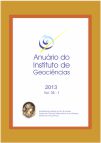Marine Influence Record by the Distribution of Benthic Foraminifera in the Guanabara Bay, Rio de Janeiro State, Brazil
DOI:
https://doi.org/10.11137/2013_2_117_128Abstract
Sediment samples in the Guanabara Bay and the adjacent coastal area were analyzed to characterize the marine influence level inside the Bay. Twenty nine samples were studied, as follows: 15 inside the Bay, including the Norwest and central area, two in front of the Bay, and 12 in the coastal region, in front of the Copacabana beach, in the Rio de Janeiro City, and Piratininga and Itaipu beaches, in the Niterói City. Collection at the sediment-water interface was performed with the Van Veen sampler, and the samples were treated by foraminifera specific treatment at the laboratory. Benthic foraminifera abundance inside the bay was higher than in the coastal region, however, diversity and richness values were lower. The present study recorded the marine species distributions like Bucella peruviana and Eponides repandus, indicating the ACAS influence in the bay area, as well as opportunist species and TOC high levels characteristic species like Ammonia tepida and Buliminella elegantissima. The presence of Pararotalia cananeiaensis and Globocassidulina subglobosa was distinct in the coastal region and inside the bay. Therefore, it was possible to characterize the environment considering levels of the anthropogenic influence and the marine shelf influence. Those results can be of a great importance record to conservation, preservation and management policies of that highly degraded environment.Downloads
Download data is not yet available.
Downloads
Published
2013-01-01
How to Cite
Macedo, M. C., Vilela, C. G. and Baptista Neto, J. A. (2013) “Marine Influence Record by the Distribution of Benthic Foraminifera in the Guanabara Bay, Rio de Janeiro State, Brazil”, Anuário do Instituto de Geociências. Rio de Janeiro, BR, 36(2), pp. 117–128. doi: 10.11137/2013_2_117_128.
Issue
Section
não definida
License
This journal is licensed under a Creative Commons — Attribution 4.0 International — CC BY 4.0, which permits use, distribution and reproduction in any medium, provided the original work is properly cited.















